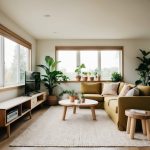Transform Your Bedroom into a Relaxing Retreat: Tips from Experts
Creating a relaxing retreat in your bedroom starts with the right decorating tips. Choose soothing colors and soft lighting to create a calming atmosphere. Neutral tones like beige, gray, and soft pastels are perfect choices. Incorporating dimmable lights or bedside lamps can enhance the relaxing mood.
Investing in comfortable and cozy bedding is essential. High-quality sheets, plush blankets, and supportive pillows can significantly improve your sleep quality. Adding a few personal touches like framed photos, artwork, or plants can make the space feel more inviting and personalized.
Decluttering the space is another critical step. A clutter-free bedroom promotes a sense of calm and order. Storage solutions like baskets, shelves, and under-bed storage can help keep things organized, ensuring that your bedroom remains a tranquil haven.
Understanding Bedroom Layout Dynamics
A well-arranged bedroom can significantly enhance relaxation and sleep quality. Focus on optimizing space and positioning the bed strategically for the best rest.
Maximizing Space and Flow
Maximizing space in a bedroom involves thoughtful furniture placement and movement flow. Start by measuring the room and noting any architectural features that might influence furniture arrangement. It’s essential to leave enough walking space around the bed and other furniture.
Use multifunctional furniture to save space. Items like storage beds or desks that double as vanity tables can help eliminate clutter. Placing furniture against walls can often make the central space feel more open and accessible.
Lighting also affects how spacious a room feels. Natural light makes a room feel bigger, so consider the placement of windows and ensure they aren’t blocked by furniture. Adding mirrors can reflect light and give the illusion of more space.
Bed Positioning for Optimal Sleep
The bed’s position is crucial for a restful sleep environment. Placing the bed against a solid wall can provide a sense of stability and security. Aim to position the bed so that you have a clear view of the door without being directly in line with it.
Avoid placing the bed under windows where drafts can disturb sleep. Electrical devices should be kept at a distance to reduce electronic disruption. Headboards can add a feeling of support and are aesthetically pleasing.
Consider Feng Shui principles by ensuring balance and symmetry. Nightstands on either side of the bed can foster a harmonious atmosphere and make the room look more organized. Successful bed positioning fosters tranquility and promotes undisturbed sleep.
Selecting a Calming Color Palette
Choosing the right colors for a bedroom can create a tranquil atmosphere. Understand the psychological impact of colors and the role of main hues versus accents.
The Psychology of Color
Colors profoundly influence mood and emotions. Blues and greens are often associated with calmness and serenity. These cool tones can lower stress levels and promote relaxation.
Neutral shades like beige, gray, or soft whites offer a peaceful environment. They also provide versatility for different styles. Avoid overly bright colors such as red or orange, as they can be too stimulating for a restful space.
Warm tones like pastels can also be soothing. Soft pinks and lavenders can add warmth without overwhelming. Consider the emotional response each color evokes to achieve the desired ambiance.
Wall Colors vs. Accent Hues
The walls should feature the primary calming color. Larger surfaces often dominate the room’s feel, so choose a serene hue for the walls. Soft blues, muted greens, or gentle grays work well for creating a calm backdrop.
Accent hues, such as those in pillows, throws, or artwork, provide visual interest. They should complement the wall color, adding depth without overpowering. For instance, if the walls are light blue, accents in deeper blue, white, or soft green can create a cohesive look.
Balance is key. Too many accent colors can detract from the relaxing atmosphere. Stick to two or three accent hues that harmonize with the main wall color for an inviting, restful retreat.



